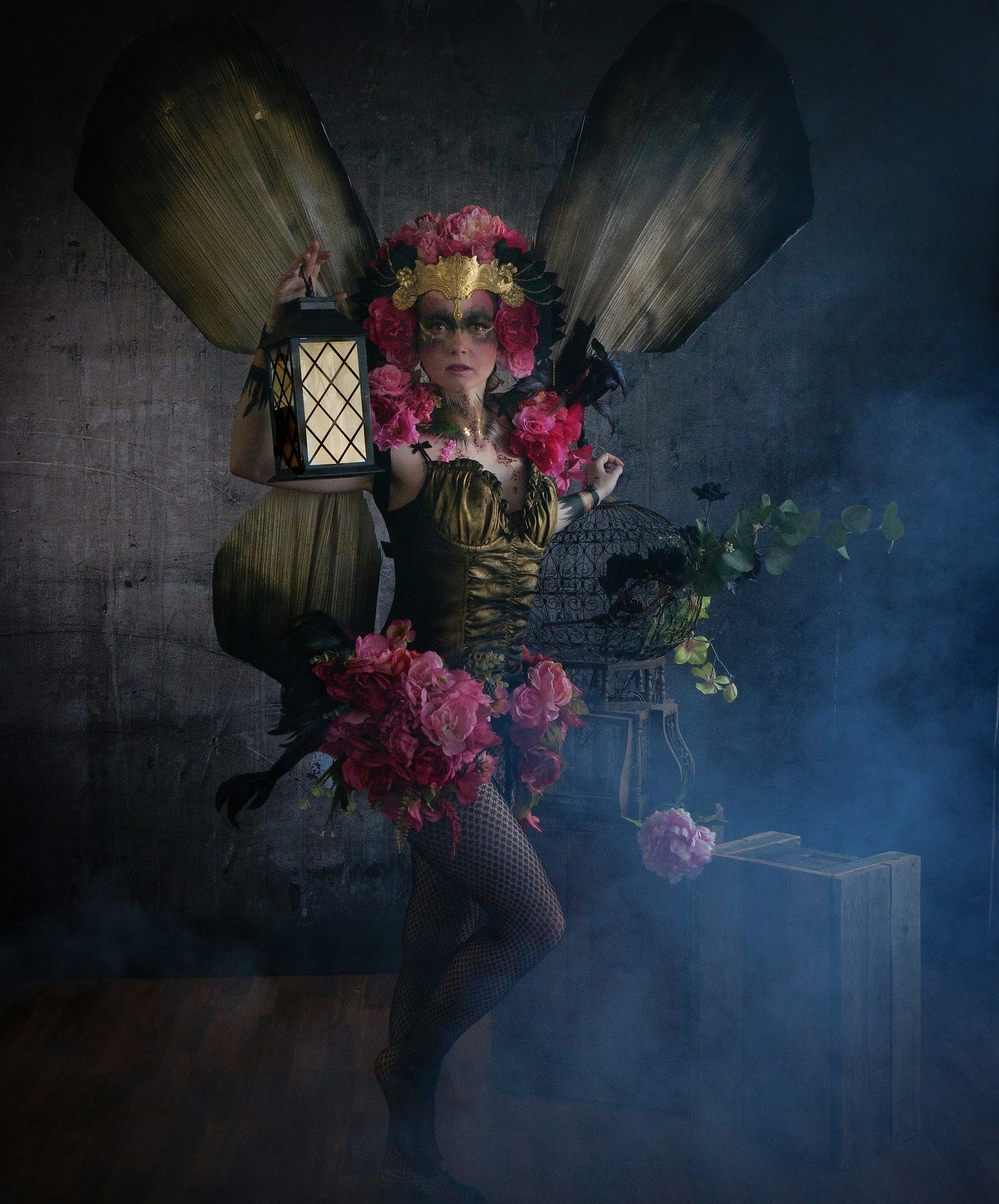Like any art, the creation of self is both natural and seemingly impossible.
It requires training as well as magic.
〰 Holly Near 〰
The Death of the Ego
Dying is something we human beings do continuously,
not just at the end of our physical lives on this earth.
〰 Elisabeth Kübler-Ross 〰
In the vernacular ~ where language comes alive on tongues and in minds of all of us folks ~ ego has become a negative word. Synonymous on one hand with assurance, confidence, pride, self-assertion, self-confidence, self-esteem, self-regard, self-respect, self-trust, self-worth, it doesn’t sound too bad.
On the more dominant hand, ego conjures up associations with arrogance, bigheadedness, condescendence, egotism, haughtiness, presumption, pretension, pridefulness, self-centredness, self-conceit, self-glory, self-importance, self-righteousness, sense of superiority or supremacy, vanity.
‘Having a Big ego’ implies an inflated sense of self-importance.
‘Being on an egotrip’ describes activities to enhance one’s self-image, one’s self-importance, one’s self-worth.
‘To ‘boost’ or ‘massage’ someone’s ego’ is another expression for flattery, doing or saying things to make a person feel proud and important, to enhance someone’s sense of self-worth ~ not necessarily based on genuine approval, respect, or admiration.
None of those ego-maniac-words or phrases feel good. They make me want to get rid of that ‘horrible ego’ because they sound fake. Anything to do with ‘ego’ ~ in current everyday language ~ has that artificial flavour. Despite all the positive and nourishing ingredients many great minds have poured into that ego-cauldron (see part 2/3).
Even Buddhism acknowledges a ‘healthy ego’ ~ rather quietly ~ in passing… (sadly, in Western interpretation it sounds like an afterthought, after bashing all the self-grasping and self-centredness of inflated and deflated egos on their heads…)
In the steaming ego stew ~ bubbling and boiling within the alchemical brew of the incumbent human mind and psyche, filled with limited understanding, infinite ignorance, AND a generous helping of a fragile sense of self-worth ~ the ego always seems to rise to the top like scum forming on the surface when making jam. Always appearing belly-up showing its unsavoury side.
This behaviour is particularly curious, since the ego does have healthy and powerful faces too. It is almost as if the ego is trying to tell us something. As if it is sending a message that it is ready to surrender, willing to die.
Ego death is a term coined by Timothy Leary who wrote The Psychedelic Experience: A Manual Based on the Tibetan Book of the Dead (1964). As a psychonaut, Leary experienced ego death through use of psychedelics. The concept itself has been known in all spiritual and shamanic traditions and does not require the use of drugs.
In a nutshell, ego death allows a person to temporarily lose their sense of self. It can happen spontaneously through a near death experience, a traumatic event, deep grief after the loss of a loved one, a serious illness, or in a therapy session, e.g. due to flashback to your own birth.
Or it can be induced voluntarily by spiritual practices, shamanic rituals, psychedelic substances, breathwork, or other exercises.
Why would you want to do that?
The temporary loss of the sense of self is the human equivalent to a snake shedding an old skin. It’s a transformational process which includes the death of some version of yourself with which you’ve identified, and the birth of another, more authentic version of yourself yearning to come into being.
Ego death sounds very dramatic because of our associations with death. In reality it is only the belly-up part of the ego that dies in the process, freeing you to become more fully yourself.
In the 19th century, the American philosopher and psychologist William James (1842-1910) used the term self-surrender to describe the same phenomenon. Carl G. Jung (1875-1961) referred to it as psychic death.
Joseph Campbell (1904-1987) told the same story through mythology and metaphor framed as the ‘Hero’s journey’ (aka Monomyth) in The Hero with a Thousand Faces. Czech-American psychiatrist and founder of Holotropic Breathwork Stanislav Grof (*1931) speaks and writes about it in terms of the ‘Dark Night of the Soul’.
According to Grof, the experience of ego death occurs naturally during birth. What dies in the process is “a basically paranoid attitude toward the world which reflects the negative experience of the subject during childbirth and later.”
Self & Ego as Masks of Good, Bad & Ugly
The ego is a fascinating monster.
〰 Alanis Morisette 〰
The ego doesn’t really die in the processes of the so-called ego death suggested above. On the contrary, it becomes stronger, in the sense of healthier. An unhealthy ego may appear big, while a healthy ego goes unnoticed, much like a healthy tooth or limb.
In their book Ego (2011), Peter Baumann and Michael Taft define the ego as the function of the human brain which produces stories about oneself, and coordinates all efforts to present this perception.
Contrary to popular negative belief and associations with the word ~ in the understanding of contemporary psychology ~ the ego has important functions in individual and collective human life.
According to modern psychology, ego…
…plays a key role in the development of identity and sense of self
…shapes self-image, influences mindset, and informs beliefs
…serves as a protector and mediator between internal wishes and external demands
…is largely responsible for reality checks and decision making
In anthropocentric culture, the self has been cast in fragmented roles, charged with positive and negative features. We have been told that humans have a ‘good’ (= true, real, authentic, higher) self, and one or several ‘bad’ (= false, lower, malignant, narcissistic, pseudo) selves.
We should be more self-aware less self-centered, more self-actualised less self-absorbed, more self-disciplined less self-opinionated, self-sufficient without being too selfish, etc…. no wonder our self gets lost and confused…
Meanwhile the ego has been assigned the role of the ‘ugly’. A ‘Big’ ego has all the bad traits of being selfish, self-opinionated, self-absorbed, self-centred, and worse. It is egoistic, egotistic, egocentric, egomaniac, egocratic, egoclastic, egoplectic, all of which comes with a high risk of turning into an egotripping egosaurus.
Where did these labels come from?! Remember that these two characters ~ self and ego ~ were born and bred by the anthropocentric mind only in the past 100 years!
Let’s take another look at them through the unprejudiced symbiocentric lens and give our self and ego a fresh chance to introduce themselves, without all the baggage.
First of all, ‘big ego’ is a total misnomer. This creature is in a reality a little imp. A pesky-piskie-wannabe-giant. Big ego has never been big. Not even middling. It has been a cover up for a weak little fragile ego all along.
When humans feel inferior in their own being, they resort to the ego as a mask to hide behind. The mask is supposed to cover up the assumed weakness to make the individual look and feel stronger or ‘bigger’. To this end, the mask for inferiority becomes superiority ~ its polar counterpart.
Does this mean the ego is superior or inferior? Of course neither. Ego is only a mask which can be anything you want. Ego is a ’slave’ produced by anthropocentric human consciousness as part of a survival strategy.
At the same time, ‘the self’ has been shredded to bits by many schools of human thought. If we truly had all these different selves, we’d all end up suffering with a personality disorder.
Who is the real self really?
The verbiont |self| started its life in human language as a reflexive pronoun, remember? This means, it can stand in for the individual it refers to:
me › myself, you › yourself, she › herself, he › himself,
we › ourselves, you (pl) › yourselves, they › themselves.
Self and its plural form selves can express
… reflexiveness, self-responsibility › I did this to myself
… independence, solitude › can you do this by yourself?
… authenticity, openness, intimacy › she can be herself with her friends
… an inner state of balance, loss of inner peace › he was beside himself with worry
… exclusivity, privacy › we need to be by ourselves
… representation, delegation › what you do will benefit others beyond yourselves
… perception, awareness › this is how they see themselves
Meeting self and ego directly, allows us to see them as they are, rather than taking on roles into which they have been boxed. Both reveal themselves as infinitely versatile. Both are key functions of human Consciousness, enabling us to see ourselves from multiple angles, communicate with ourselves, and shift from one state of being into another, as required.
Over the past century, our ancestors have viewed self and ego from the outside, through anthropocentric, objectifying lenses, and projected what they saw onto the inside.
A glance through the ‘symbiocentric introscope’ reveals a fresh appearance, releasing self and ego from the shackles of prejudices and outdated beliefs, which ultimately undermine ourselves, mess up our self-image and confuse our self-recognition.
Self and ego are loyal and reliable companions, offering their services for self-care, self-knowledge, and self-empowerment. They are not fixed, neither good nor bad, and definitely not as ugly as they have been portrayed.
In the new symbiocentric field theory of Synchronosophy, Self is defined as self-perception, and Ego as ego-identification. These definitions give a clue of the important roles this power duo can play within human Consciousness, if we stop abusing or vilifying them and interfering with their jobs.
(More about the Self and Ego in symbiocentric understanding in Chapter 20 of Synchronosophy: Experiencing Moments of Living)
Shapeshifting Selves in a Slippery World
I wasn’t meant for reality, but life came and found me.
〰 Fernando Pessoa 〰
The Olmec ~ the first known civilisation of Mesoamerica (1200-400 BCE) ~ viewed the world as a fluid reality. Their cosmology describes a dynamic constantly regenerating system interconnected with invisible cosmic forces.
Growing out of the Olmec ‘mother culture,’ the Mayans (2000 BCE-early 16th century) saw the world as cyclical, a cosmic tree suspended between heaven and earth. For the Aztecs (14th-16th century) the earthly reality was a treacherous existence ~ a slippery world between layers of a dark underworld below and heavenly realms above, where humans lived in permanent risk of losing their balance.
In all these ancient Mesoamerican cultures, the boundaries between the human world and their natural environment were permeable. Every human had a spirit animal, which played a significant role in spiritual transformation and social identity of the individual.
Animals, natural phenomena, and/ or supernatural beings were permanent spirit companions of humans, linked to a person’s life force and identity. This reflects the ancient concept of the alter ego shared by many shamanic traditions from the Americas to Siberia, Mongolia and beyond.
In present anthropocentric culture, alter egos are popular among celebrities, including Beyoncé, Adele, Lady Gaga, Rowan Atkinson, Kobe Bryant, Eminem, Prince, and other athletes and artists. These alternate selves serve the purpose of personal empowerment and emotional support. They protect the individual’s private self and help them cope with the challenges of a demanding public life.
In everyday language, the concept of alter ego has been blended and blurred with alias, pseudonym, avatar, and doppleganger.
Social media platforms invite users to create an alter ego. Personal profiles are spaces where anyone can curate online versions of themselves using invented names, photoshopped visual representations and selective ‘autobiographical’ details disconnected from their offline identity in ‘real life’.
While the ancient Mesoamerican |alter ego| carried profound transformative power ~ through interaction between everyday awareness and ego (known as tonal) and the deeper human self, its limitless spirit and hidden potential (the so-called nagual) ~ the contemporary alter ego offers anonymity in a virtual world where anyone can pretend to be anything they want, allegedly without involvement of their ‘real selves’.
in today’s virtual-reality-culture alter-ego is used explicitly
and ostensibly to shield the real self from the real world
Creating an online alter ego is considered a ‘healthy, sane, and normal’ use of this concept, as opposed to the pathological expressions in the form of dissociative disorders (although potential negative effects of online alter egos on mental illhealth have been acknowledged).
The lure of assuming an alter ego is to be able to temporarily step beyond the boundaries of one’s current mundane self-perception and ego-identification into another persona, to experience life in a parallel world, or act in this world as another person.
Among writers it is not uncommon to do this. Amantine Lucile Aurore Dupin adopted her alter ego George Sand in 1831, long before the invention of social media. Agatha Christie wrote romance novels as Mary Westmacott. Theodor Geisel and Daniel Handler used their alter egos to write for children ~ the first as Dr. Seuss, the second as Lemony Snicket.
The uncontested champion of creating alter egos (over 100!) is the Portuguese poet and author Fernando Pessoa. He called them heteronyms. Each had their own name (of course), a distinct writing style, literary genre, a whole life of their own. He created detailed biographies, endowing each with their own birthplace, professional career, political views, religious beliefs, and literary pursuits, even had them engage in literary and philosophical debates with each other.
When over 25’000 unpublished papers were found in a large wooden trunk after the reclusive poet’s death, dozens of unknown alter egos, “suddenly stepped into the world as if awakened from an enchanted sleep.”
In his trilogy of fantasy novels His Dark Materials, British author Philip Pullman picked up the theme of spirit animals (aka Daimons) who accompany each of the human characters in the story. Unlike the spirit animals of the shamanic traditions, these are physical animals reflecting an aspect of their human’s personality, offering emotional support and lifelong companionship. In other words, Pullman’s Daimons blend the alter ego with the personality of the character.
Although we have lost the gift of shapeshifting, the ability to call on spirit animals (and other beings) is still alive, both in the creative world of writers and in spiritual practices. In its healthy form, alter ego was never meant to be assumed as a ‘new permanent identity’ but rather a spirit companion to call on, whose perspective we can borrow, for a time.
In the creative writing process, alter ego can overlap with the creative daimon (= the creative genius, or writing spirit) mentioned by Elizabeth Gilbert in her inspiring TED talk ‘Your elusive creative genius.’
Alter ego, in this sense, can become the third companion to join the self and ego duo. What if our alter ego is the inner shape shifter, ready to empower us to shift ourselves out of a trap, a bewildering conflict, or a life outgrown?
What if the alter ego has the power to open our horizon beyond any current ego-identification and self-perception ~ if only temporarily ~ to show an alternate way, or offer a springboard for a leap of faith?
No matter which culture, era, or civilisation, I don’t think alter ego was ever meant to take over anyone’s life. It was never meant as an escape route from the life we were born into.
It does seem to have an intimate connection with another personal companion ~ beyond the limited frames of self-perception and ego-identification ~ who acts as a bridge to an aerial view, where you can see yourself from a higher vantage point. Whether you call it spirit animal or creative daimon, the alter ego, may still have the power to shift the shape of your personal slippery world.







Ah Veronika! So much to connect on ego and self that I find my”self” rummaging through the naming of understanding in search of that nameless invisible elusive naked kiss of meaning. As usual your flow of writing is a gift to us readers.
Chapter 20 in your book would be as close as “I” get to that quest for meaning on self and ego. Both great friends and guides on this soul journey of “being” human. Re-reading chapter 20 is a light going off! Thank you!
Did or do I have an alter ego? We all do somehow. I often ask “What needs to be done” and …”who…must I Be to accomplish it”.
The Noctarine is a great map to the invisible. Consciousness seems to have more than one voice. Now that is another series.
Thanks for Being- Here. Another wow to read into the spaces of a few more times today.
Thanks for sharing your gift. 🙏❤️
I take your writing seriously and have decided to read Synchronosophy from the beginning. Chapter 1 resonates.
I wanted to reply at his substack a few days ago following Josh's latest poem, but have held the draft, which had turned out to be a fuller account than I attempted before of the key timing of a gift for me from friends of friends, co-incident with the telling of a legend of a mythical serpent in our local landscape.
I will have another ponder and keep reading your chapters.
PS I've noticed the words character and soul wander into this discussion, perhaps from our bookish past, and they still resonate.